人教版新教材必修二Unit4 History and traditions课件(27张)
文档属性
| 名称 | 人教版新教材必修二Unit4 History and traditions课件(27张) |
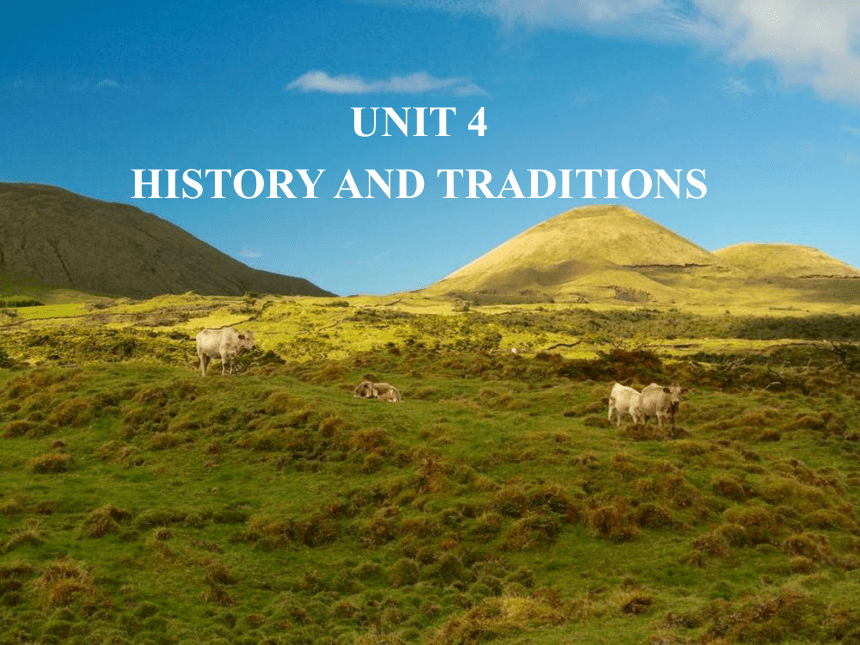
|
|
| 格式 | pptx | ||
| 文件大小 | 4.0MB | ||
| 资源类型 | 教案 | ||
| 版本资源 | 人教版(2019) | ||
| 科目 | 英语 | ||
| 更新时间 | 2020-12-25 08:01:59 | ||
图片预览



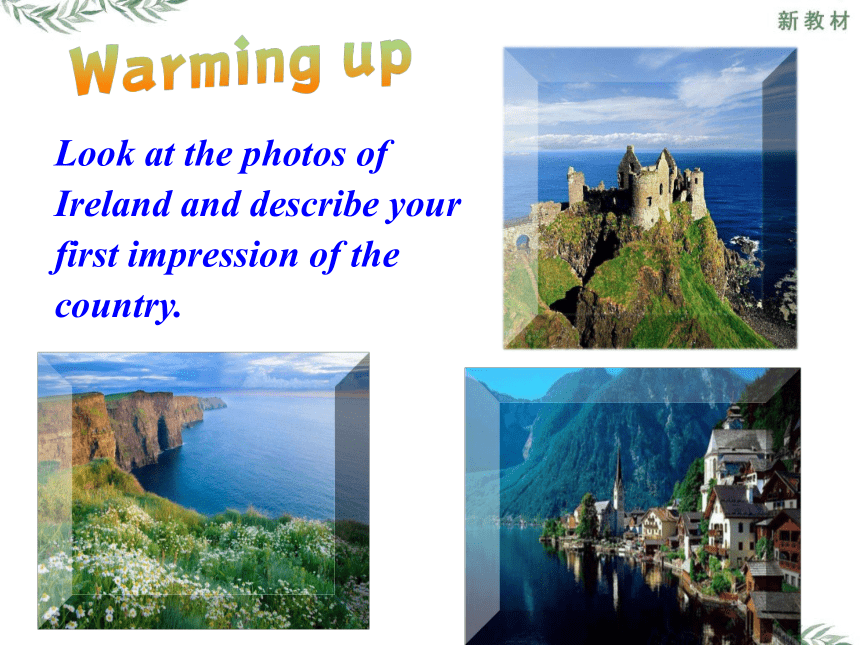
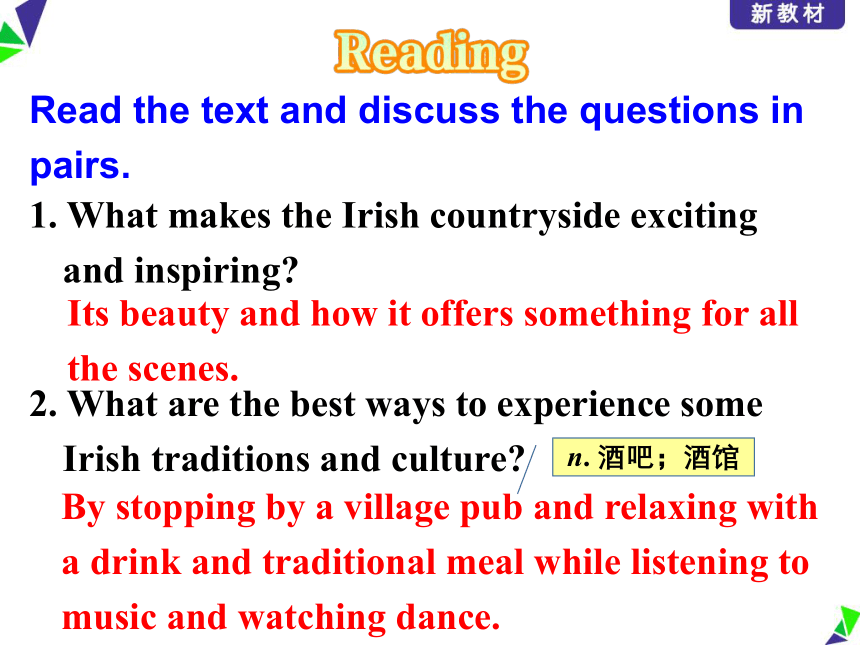


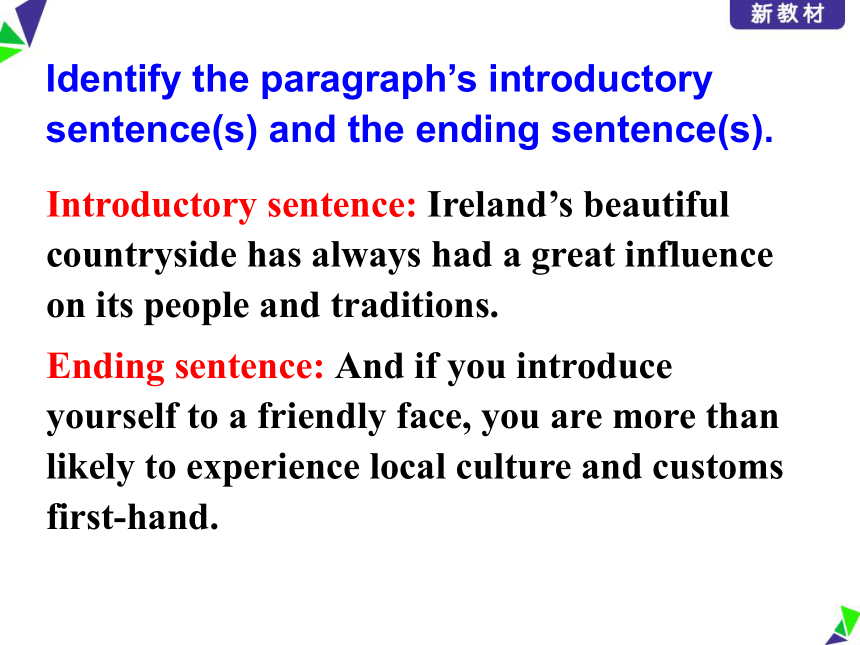
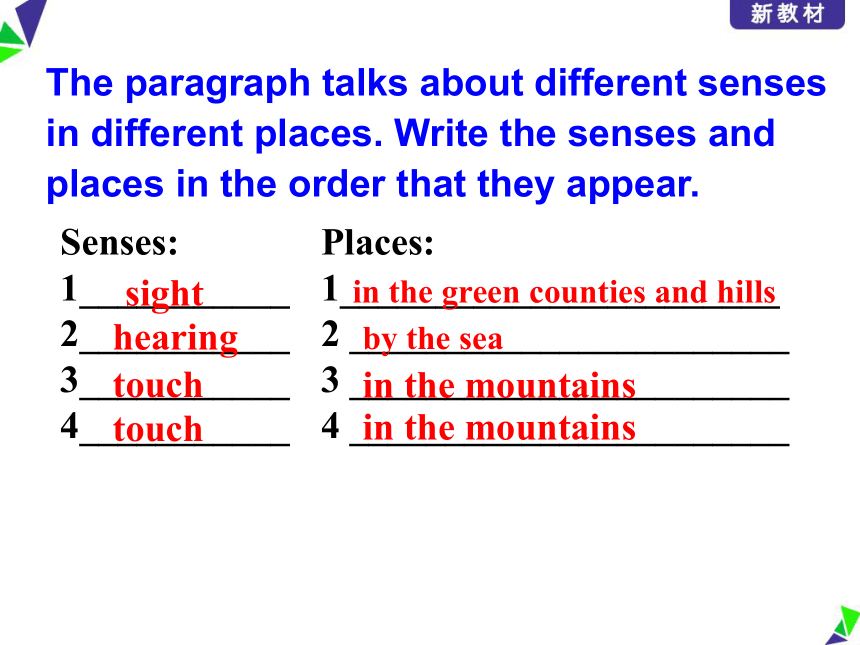
文档简介
UNIT 4
HISTORY AND TRADITIONS
In this period, you will:
1. read a descriptive paragraph about
Ireland.
2. identify and analyse the introductory
sentences.
3. write to describe an interesting,
exciting or surprising place.
Look at the photos of Ireland and describe your first impression of the country.
Read the text and discuss the questions in pairs.
1. What makes the Irish countryside exciting and inspiring?
2. What are the best ways to experience some Irish traditions and culture?
By stopping by a village pub and relaxing with a drink and traditional meal while listening to music and watching dance.
Its beauty and how it offers something for all the scenes.
n. 酒吧;酒馆
3. What is the meaning of “breathe in the sweet scent of fresh flowers while birds greet the new day with their morning song”?
4. What are the best ways to experience Chinese traditions and customs?
It means to not just smell but also breathe in the smell of fresh flowers early in the morning as the birds sing their first song of the new day.
By travelling to different places and using all your senses to experience everything and by interacting with local people.
n. 风俗;习俗
vt. 问候;迎接
rolling green hills
sheep and cattle
Emerald Isle
down by the sea
in the mountains
a village pub
Complete the mind map with different senses in the four places.
the sun on the skin
sweet scent of fresh flowers
birds' morning songs
the roar of the ocean waves
cries of the seabirds
wine and local beer
traditional Irish Beef Stew
traditional music and dancing
Identify the paragraph’s introductory sentence(s) and the ending sentence(s).
Introductory sentence: Ireland’s beautiful countryside has always had a great influence on its people and traditions.
Ending sentence: And if you introduce yourself to a friendly face, you are more than likely to experience local culture and customs first-hand.
The paragraph talks about different senses in different places. Write the senses and places in the order that they appear.
{21E4AEA4-8DFA-4A89-87EB-49C32662AFE0}Senses:
1___________
2___________
3___________
4___________
Places:
1_______________________
2 _______________________
3 _______________________
4 _______________________
sight
in the green counties and hills
hearing
by the sea
touch
touch
in the mountains
in the mountains
What words does the writer use to describe sensory details?
sight: feast for the eyes
hearing: roar, cries, music of the coast,
morning song
touch: feel the sun on your skin
smell: sweet scent
taste: delicious
n. 气味;气息
阅读景物描写的文章时要注意文中修辞手法的运用,如在… breath in the sweet scent of fresh flowers while birds greet the new day with their morning song中,greet使用了拟人的修辞手法,让句子生动活泼,增强了画面感。
Choose one of your favorite places and tell a partner why you think it is interesting, exciting, or surprising. Use the questions below to describe the place you have chosen.
What can you see?
What can you hear?
How does the place feel?
What can you smell?
What can you taste there?
What does the place make you think or feel?
Introduction
Make the reader eager to read your writing
A striking image
Something surprising
A quote or question
In my village, every day starts with a “fire”! The houses turn red as the sun rises above the mountains.
Use your answers to draft a passage about the place.
adj. 引人注目的;显著的
Body
Transitions
Help the reader follow your ideas
In the morning/ afternoon/ evening
First, second, etc.
In the north…In the east…
Details and examples
Use sensory details
Do not use general words
Give examples
What can you see, hear, smell, etc.?
I learnt a lot. What did you learn?
There were many things… What?
Some people… Who?
n. 过度;转变;变迁
Ending
Lead reader know that the passage ends
Help the reader remember your writing
At night, the stars come out to tell us that all is well and my village grows quiet. For now we’ll sleep, and tomorrow the sun will set us on fire again for a new day!
Simile: When you compare A to B using the words like or as, you are using simile.
My love is like a red rose.
Her skin is as white as snow.
Metaphor: When there is no “like” or “as”...
My love is a red rose. (metaphor)
My love is like a red rose. (simile)
Use your description to draft a passage.
In my village, every day starts with a “fire”! The houses turn red as the sun rises above the mountains.
Seeing the flames, the roosters sound the alarm. They wake everyone in the village with their loud cries, chasing the children to school and rushing the adults to work. In the evening, a gold haze settles over everything. This is my favourite time of the day, when all work for the day has been completed. When the smell of hot oil and fragrant spices float through the
air, I know that it will soon be time for dinner. My neighbours begin to call to their children to come home.
The birds begin their nightly quarrel over their
favourite places to rest.
At night, the stars come out to tell us that all is well and my village grows quiet. For now we’ll sleep, and tomorrow the sun will set us on fire again for a new day!
Exchange draft with a partner. Use the checklist to help you evaluate his/her draft.
√ Does the writer starting with an image, quote, or question?
√ Is the description well-organized and easy to read?
√ Has the writer included sensory details?
√ Dose the writer use specific words and give examples?
√ Is the ending effective?
√ Can you find any grammar or spelling mistakes?
adj. 感觉的;感官的
概要写作
阅读下面短文,根据其内容写一篇60词左右的内容概要。
Britain?is a tea-drinking nation. Every day we drink 165 million cups of tea and each year around 144 thousand tons of tea is imported (进口). The traditional way we often use to make tea is: Boil (煮沸) some fresh cold water, put some hot water into the teapot (茶壶) to make it warm, and then pour (倒) the water away. Put one teaspoon of tea-leaves per person, and one extra teaspoon, into the pot. Pour boiling water onto the tea and leave for a few minutes, then serve.
If someone asks you if you “would like a cuppa”, they are asking if you would like a cup of tea. If someone says “let me be Mother” or “shall I be Mother”, they are offering to pour out the tea from the teapot. Tea break, tea time, tea party, and many more terms have come from the tradition of drinking tea. Tea breaks are when tea and biscuits are served. The traditional time for tea breaks is at 11 am and 4 pm. If something is not quite to your taste, it's probably “not your cup of tea”.
Afternoon tea, the traditional 4 o'clock tea, is a small meal, not a drink. Afternoon tea is not common these days because most adults go out to work. However, you can still have afternoon tea at the many tea rooms around?England.
Afternoon tea began about one hundred and eighty years ago when rich ladies invited their friends to their houses for a cup of tea in the afternoon. Soon everyone was enjoying afternoon tea.
The British working people did not have afternoon tea. They had a meal about noon and a meal after work, between 5 and 7 o'clock. This meal was called “high tea” or just “tea”. Traditionally eaten early evening, high tea was a meal that included delicious sweet foods, bread, cold meats, and eggs. This meal is now often replaced
(取代) with a supper due to people eating their main meal in the evening rather than the middle of the day.
British people like drinking tea a lot, especially in a traditional way. (要点1) There are many phrases and terms related to the custom of drinking tea. (要点2) With a history of almost two centuries, afternoon tea, once a popular small meal, has lost its popularity gradually. (要点3) Besides, now the British working class have supper rather than high tea, once served as a meal after work. (要点4)
假定你是李华,你的澳洲朋友Adam发邮件说想来中国游玩,让你推荐一座历史古城。请根据所给提示,用英语给他写一封邮件。内容包括:
1.?推荐河南省洛阳市;2.?陈述推荐的原因。
注意:1.?词数100左右(开头和结尾已给出,但不计入总词数);2.?可以适当增加细节,以使行文连贯。
Dear Adam,
????????????????????????????????????????????????????????????????????? ????
______________________________________________
?Yours,
??Li Hua
HISTORY AND TRADITIONS
In this period, you will:
1. read a descriptive paragraph about
Ireland.
2. identify and analyse the introductory
sentences.
3. write to describe an interesting,
exciting or surprising place.
Look at the photos of Ireland and describe your first impression of the country.
Read the text and discuss the questions in pairs.
1. What makes the Irish countryside exciting and inspiring?
2. What are the best ways to experience some Irish traditions and culture?
By stopping by a village pub and relaxing with a drink and traditional meal while listening to music and watching dance.
Its beauty and how it offers something for all the scenes.
n. 酒吧;酒馆
3. What is the meaning of “breathe in the sweet scent of fresh flowers while birds greet the new day with their morning song”?
4. What are the best ways to experience Chinese traditions and customs?
It means to not just smell but also breathe in the smell of fresh flowers early in the morning as the birds sing their first song of the new day.
By travelling to different places and using all your senses to experience everything and by interacting with local people.
n. 风俗;习俗
vt. 问候;迎接
rolling green hills
sheep and cattle
Emerald Isle
down by the sea
in the mountains
a village pub
Complete the mind map with different senses in the four places.
the sun on the skin
sweet scent of fresh flowers
birds' morning songs
the roar of the ocean waves
cries of the seabirds
wine and local beer
traditional Irish Beef Stew
traditional music and dancing
Identify the paragraph’s introductory sentence(s) and the ending sentence(s).
Introductory sentence: Ireland’s beautiful countryside has always had a great influence on its people and traditions.
Ending sentence: And if you introduce yourself to a friendly face, you are more than likely to experience local culture and customs first-hand.
The paragraph talks about different senses in different places. Write the senses and places in the order that they appear.
{21E4AEA4-8DFA-4A89-87EB-49C32662AFE0}Senses:
1___________
2___________
3___________
4___________
Places:
1_______________________
2 _______________________
3 _______________________
4 _______________________
sight
in the green counties and hills
hearing
by the sea
touch
touch
in the mountains
in the mountains
What words does the writer use to describe sensory details?
sight: feast for the eyes
hearing: roar, cries, music of the coast,
morning song
touch: feel the sun on your skin
smell: sweet scent
taste: delicious
n. 气味;气息
阅读景物描写的文章时要注意文中修辞手法的运用,如在… breath in the sweet scent of fresh flowers while birds greet the new day with their morning song中,greet使用了拟人的修辞手法,让句子生动活泼,增强了画面感。
Choose one of your favorite places and tell a partner why you think it is interesting, exciting, or surprising. Use the questions below to describe the place you have chosen.
What can you see?
What can you hear?
How does the place feel?
What can you smell?
What can you taste there?
What does the place make you think or feel?
Introduction
Make the reader eager to read your writing
A striking image
Something surprising
A quote or question
In my village, every day starts with a “fire”! The houses turn red as the sun rises above the mountains.
Use your answers to draft a passage about the place.
adj. 引人注目的;显著的
Body
Transitions
Help the reader follow your ideas
In the morning/ afternoon/ evening
First, second, etc.
In the north…In the east…
Details and examples
Use sensory details
Do not use general words
Give examples
What can you see, hear, smell, etc.?
I learnt a lot. What did you learn?
There were many things… What?
Some people… Who?
n. 过度;转变;变迁
Ending
Lead reader know that the passage ends
Help the reader remember your writing
At night, the stars come out to tell us that all is well and my village grows quiet. For now we’ll sleep, and tomorrow the sun will set us on fire again for a new day!
Simile: When you compare A to B using the words like or as, you are using simile.
My love is like a red rose.
Her skin is as white as snow.
Metaphor: When there is no “like” or “as”...
My love is a red rose. (metaphor)
My love is like a red rose. (simile)
Use your description to draft a passage.
In my village, every day starts with a “fire”! The houses turn red as the sun rises above the mountains.
Seeing the flames, the roosters sound the alarm. They wake everyone in the village with their loud cries, chasing the children to school and rushing the adults to work. In the evening, a gold haze settles over everything. This is my favourite time of the day, when all work for the day has been completed. When the smell of hot oil and fragrant spices float through the
air, I know that it will soon be time for dinner. My neighbours begin to call to their children to come home.
The birds begin their nightly quarrel over their
favourite places to rest.
At night, the stars come out to tell us that all is well and my village grows quiet. For now we’ll sleep, and tomorrow the sun will set us on fire again for a new day!
Exchange draft with a partner. Use the checklist to help you evaluate his/her draft.
√ Does the writer starting with an image, quote, or question?
√ Is the description well-organized and easy to read?
√ Has the writer included sensory details?
√ Dose the writer use specific words and give examples?
√ Is the ending effective?
√ Can you find any grammar or spelling mistakes?
adj. 感觉的;感官的
概要写作
阅读下面短文,根据其内容写一篇60词左右的内容概要。
Britain?is a tea-drinking nation. Every day we drink 165 million cups of tea and each year around 144 thousand tons of tea is imported (进口). The traditional way we often use to make tea is: Boil (煮沸) some fresh cold water, put some hot water into the teapot (茶壶) to make it warm, and then pour (倒) the water away. Put one teaspoon of tea-leaves per person, and one extra teaspoon, into the pot. Pour boiling water onto the tea and leave for a few minutes, then serve.
If someone asks you if you “would like a cuppa”, they are asking if you would like a cup of tea. If someone says “let me be Mother” or “shall I be Mother”, they are offering to pour out the tea from the teapot. Tea break, tea time, tea party, and many more terms have come from the tradition of drinking tea. Tea breaks are when tea and biscuits are served. The traditional time for tea breaks is at 11 am and 4 pm. If something is not quite to your taste, it's probably “not your cup of tea”.
Afternoon tea, the traditional 4 o'clock tea, is a small meal, not a drink. Afternoon tea is not common these days because most adults go out to work. However, you can still have afternoon tea at the many tea rooms around?England.
Afternoon tea began about one hundred and eighty years ago when rich ladies invited their friends to their houses for a cup of tea in the afternoon. Soon everyone was enjoying afternoon tea.
The British working people did not have afternoon tea. They had a meal about noon and a meal after work, between 5 and 7 o'clock. This meal was called “high tea” or just “tea”. Traditionally eaten early evening, high tea was a meal that included delicious sweet foods, bread, cold meats, and eggs. This meal is now often replaced
(取代) with a supper due to people eating their main meal in the evening rather than the middle of the day.
British people like drinking tea a lot, especially in a traditional way. (要点1) There are many phrases and terms related to the custom of drinking tea. (要点2) With a history of almost two centuries, afternoon tea, once a popular small meal, has lost its popularity gradually. (要点3) Besides, now the British working class have supper rather than high tea, once served as a meal after work. (要点4)
假定你是李华,你的澳洲朋友Adam发邮件说想来中国游玩,让你推荐一座历史古城。请根据所给提示,用英语给他写一封邮件。内容包括:
1.?推荐河南省洛阳市;2.?陈述推荐的原因。
注意:1.?词数100左右(开头和结尾已给出,但不计入总词数);2.?可以适当增加细节,以使行文连贯。
Dear Adam,
????????????????????????????????????????????????????????????????????? ????
______________________________________________
?Yours,
??Li Hua
